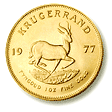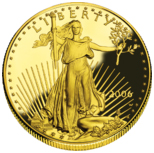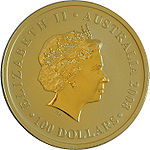Here are four of the best-known gold bullion coins.
Krugerrand

Introduced in 1967, the Krugerrand is produced by the South African Mint Company. On the obverse (front) side of the coin is the bust of Paul Kruger, who was the 5th President of the South African Republic (1883-1900). On the reverse (back) side is a springbok, which is a South African gazelle. It is the national animal of South Africa and is the name of South Africa’s national rugby team (the Springboks). While it has no face value inscribed, it does have the amount of gold content.
The Krugerrand is the first gold coin to ever contain exactly one (1.000) troy ounce of fine gold. It weighs 33.9303 g and is minted from gold alloy that is 91.67% pure (22 karat fineness), the remaining 8.33% of its weight being copper (aka crown gold).
In 1980, three smaller coins were introduced, each with a gold fineness of 91.67%: 1/2 ounce (wt: 16.9636 g; gold: 0.50 troy oz); 1/4 ounce (wt: 8.4818 g; gold: 0.250 troy oz); and 1/10 ounce (wt: 3.393 g; gold: 0.110 troy oz).
American Gold Eagle

Introduced in 1986, the American Gold Eagle is produced by the United States Mint. On the obverse (front) side of the coin is Lady Liberty, holding a torch in her right hand and an olive branch in her left. On the reverse (back) side is an eagle soaring above his nest. On it is inscribed the amount of gold content, the date, and its face value (although its actual value is the intrinsic value the amount of gold in it).
Gold Eagle coins minted 1986-1991 are dated with Roman numerals. However, in 1992, the U.S. Mint switched to Arabic numbers.
It is offered in four denominations, each minted from gold alloy that is 91.67% fine (22-karat). By law, the gold must come from sources in America, with an additional alloy of 3% silver and 5.33% copper.
A proof version for coin collectors is produced at the West Point Mint in West Point, New York, and carries the mint’s mark (“W”) beneath the date.
The weight of the 1-ounce American Gold Eagle is 1.0909 troy oz (33.930 g), the face value is US $50, and it contains one troy ounce of pure gold. The other three coin sizes include: 1/2 ounce (wt: 16.965 g; face value: US $25; gold: 0.500 troy oz); 1/4 ounce (wt: 8.483 g; face value: US $10; gold: .250 troy oz); and 1/10 ounce (wt: 3.393 g; face value: US $5; gold: 0.100 troy oz).
Canadian Gold Maple Leaf

Introduced in 1979, it was the first pure, 24 karat gold bullion coin on the market. It is 99.99% pure gold. The Canadian Gold Maple Leaf is produced by the Royal Canadian Mint, and has been in continuous production longer than any other pure gold bullion coin. By law, the gold used to make the coins must be mined in Canada.
It has legal tender (currency) status in Canada, but the face value is much lower than their market value.
Each Gold Maple Leaf coin features the image of Queen Elizabeth II (head of state of Canada), plus the denomination and date of issue, on the obverse (front) side. 1979-1989, it shows the Queen at age 39. Since 1990, the Queen is shown at age 64.
On the reverse (back) side is the maple leaf (Canada’s national symbol), “CANADA,” and the level of purity of the gold.
The only drawback, from an aesthetic point of view, is that when you purchase Gold Maple Leaf coins, you might find “handling marks” because 24 karat gold is so soft. It isn’t meant to be handled but rather kept as an investment. However, those marks won’t diminish the value of the gold.
The weight of the 1-ounce Canadian Gold Maple Leaf is 31.1030 g, the face value is C $50, and it contains one troy ounce of 24 karat (99.99%) pure gold. Three other coin sizes include: 1/2 ounce (wt: 15.5515 g; face value: C $20; gold: 0.500 troy oz); 1/4 ounce (wt: 7.7758 g; face value: C $10; gold: .250 troy oz); and 1/10 ounce (wt: 3.1103 g; face value: C $5; gold: 0.100 troy oz).
Australian Gold Nugget

Introduced in 1986 by the Gold Corporation (owned by the government of Western Australia), the Australian Gold Nugget is produced by the Perth Mint.
It is unusual in several ways. It has legal tender (currency) status in Australia. The obverse (front) side of the coin features a profile view of the face of Queen Elizabeth II, as designed by Ian Rank Broadley. She is surrounded by her name, the denomination of the coin, and the word “AUSTRALIA.” However, the reverse (back) side of the coin changes its design every year, and as a result sometimes raises its numismatic value over the intrinsic value of the gold used.
It is unique in the fact that it features a two-tone frosted design effect, and individual hard plastic encapsulation of each coin.
The back of the coin had a variety of pictures of Australia gold nuggets from 1986 to 1989. But beginning with the 1989 proof edition, the nuggets were replaced with pictures of kangaroos. Therefore these coins are now sometimes referred to as “Australian Gold Kangaroos” instead of “Australian Gold Nuggets.”
CAUTION: Do not confuse the Australian Gold Nugget coins with the Australian Lunar Gold Bullion coins. While both are produced by Perth Mint and have .9999 purity, the Lunar coins feature images from the Chinese calendar instead of the kangaroo.
It is offered in several denominations, each minted from gold alloy that is 99.99% fine (24 karat). The weight of the 1-ounce Australian Gold Nugget is 31.1030 g, the face value is A $100, and it contains one troy ounce of pure gold.
Smaller coin sizes include: 1/2 ounce (wt: 15.5515 g; face value: A $50; gold: 0.500 troy oz); 1/4 ounce (wt: 7.7758 g; face value: A $25; gold: .250 troy oz); 1/10 ounce (wt: 3.1103 g; face value: A $15; gold: 0.100 troy oz); and 1/20 ounce (wt. 1.5552 g; face value: A $5; gold: 0.050 troy oz).
Larger coin sizes include: 2 ounce (wt: 62.21 g; face value: A $500 in 1991, and A $200 1992-present; gold: 2.000 troy oz); 10 ounce (wt: 311.0 g; face value: A $2500 in 1991, and A $1000 1992-present; gold: 10.00 troy oz); and 1 kilo (wt: 1000 g; face value: A $10,000 in 1991, and A $3000 1992-present; gold: 32.154 troy oz).